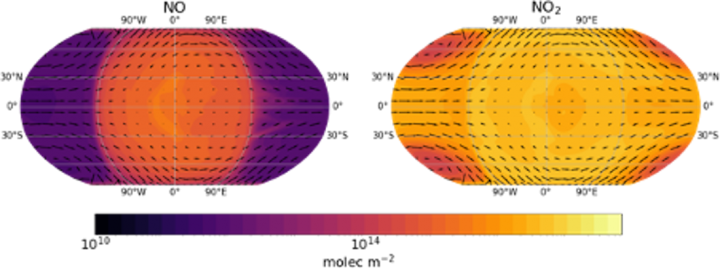Lightning-induced chemistry on tidally-locked, Earth-like exoplanets
Using a 3-D coupled climate-chemistry model (CCM), we investigate the emergence of lightning and its chemical impact on the atmospheres of tidally-locked Earth-like exoplanets (nominally Proxima Centauri b). In a tidally-locked orbit, one side of the planet faces the star at all times, leading to dayside-nightside distinctions in the planetary environment.
Using a 3-D coupled climate-chemistry model (CCM), we investigate the emergence of lightning and its chemical impact on the atmospheres of tidally-locked Earth-like exoplanets (nominally Proxima Centauri b). In a tidally-locked orbit, one side of the planet faces the star at all times, leading to dayside-nightside distinctions in the planetary environment.
A 3-D CCM is a comprehensive model of a planetary atmosphere, consisting of two distinct components. A general circulation model (GCM) is used to simulate atmospheric dynamics, the passage of radiation through an atmosphere, the formation of clouds, and the formation of lightning flashes. Coupled with the GCM, we use a photochemical kinetics code to calculate the rates of chemical reactions in the atmosphere as a function of pressure, temperature, and incoming (UV) radiation. In this way,
we simulate the planetary climate along with the atmospheric chemistry. Such GCMs and CCMs are used for weather (short-term) and climate (long-term) prediction for Earth and form the basis of, for example, the reports of the Intergovernmental Panel on Climate Change (IPCC).
Agreeing with earlier studies, we find that the tidally-locked orbit of Proxima Centauri b causes a temperature gradient between the dayside and nightside, resulting in a strong equatorial jet that flows eastward all around the planet. As a consequence of the incoming stellar radiation, convection (warming and subsequent rising of air) mainly happens on the dayside of the planet. Therefore, thick convective clouds form on the dayside. As we know from Earth, thunderstorms are most likely to emerge in such convective clouds. The first animation shows the distribution of lightning flashes and their preference for the planet’s dayside (centred at 0° latitude and longitude). Due to weaker convection and lower average atmospheric temperature, the flash rates are slightly lower than those found over the Earth’s oceans.
- Video: Lightning-induced chemistry on tidally-locked, Earth-like exoplanets
- Simulated lightning flash rates on Proxima Centauri b as a function of time. The dayside is located at 0° latitude and longitude.
The main constituents of an Earth-like atmosphere are molecular nitrogen (N2) and oxygen (O2). Lightning flashes provide high-temperature channels (up to 30000 K) that can dissociate the strong bonds within these molecules, producing nitrogen oxides (NOx). This chemical family consists of nitric oxide (NO) and nitrogen dioxide (NO2). Figure 2 shows the spatial distribution of NO, indicating how many molecules are present in a vertical column through the atmosphere. We can see that NO is produced in the regions of thunderstorms and then spreads around the dayside. Under the impact of stellar radiation, there is a balance between NO and NO2. The equatorial jet transports NOx towards the nightside, shown by the outflows crossing the meridian at 90° East. On the nightside, NOx is converted into more complex species that are no longer destroyed by photolysis, due to the absence of stellar radiation. Hence, species such as nitrate (NO3) can accumulate and act as so-called reservoirs, producing chemical contrasts between the planetary dayside and nightside.

On Earth, NOx can destroy ozone (O3) in the stratosphere. We find lightning-induced NOx at altitudes below the stratospheric ozone layer. Combined with relatively low levels of NOx, the impact on the ozone layer is negligible. Instead, oxygen photolysis and the hydrogen oxide catalytic cycle determine the extent of the ozone layer.
The contrasts between the planet’s dayside and nightside illustrate the 3-D nature of (exo)planetary atmospheres, especially when considering tidally-locked orbits. The adaptation of CCMs to exoplanets gives us insights into the workings of their atmospheres and thus helps the interpretation of future observations. At the same time, studying such extreme atmospheric regimes can also teach us about the past and future of Earth’s atmosphere and climate.
References:
Braam, M.; Palmer, P.I.; Decin, L.; Ridgway, R.J.; Zamyatina, M.; Mayne, N.J.; Sergeev, D.; Abraham, N.L., Lightning-induced chemistry on tidally-locked Earth-like exoplanets, 2022, accepted, Monthly Notices of the Royal Astronomical Society.
This study was led by Marrick Braam and appeared in MNRAS. This project has received funding from the European Union’s Horizon 2020 research and innovation programme under the Marie Sklodowska-Curie grant agreement no. 860470.

